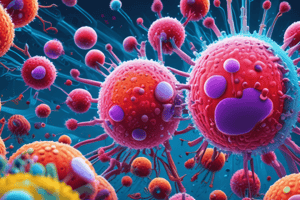Podcast
Questions and Answers
What is the process of creating immunity, or resistance to infection, in an individual?
What is the process of creating immunity, or resistance to infection, in an individual?
- Disinfection
- Immunization (correct)
- Cleansing
- Sterilization
Which method is used to destroy all microorganisms including spores?
Which method is used to destroy all microorganisms including spores?
- Moist heat (steam) (correct)
- Dry heat
- Disinfection with alcohol
- Ethylene oxide gas
What is the goal in breaking the chain of infection between the portal of exit and the mode of transmission?
What is the goal in breaking the chain of infection between the portal of exit and the mode of transmission?
- Eliminate infection before it begins
- Ensure asepsis and wear barrier protection
- Encourage clients to cover their mouths and noses when sneezing or coughing
- Prevent the exit of infectious agents (correct)
What is the most common sterilization technique used in the hospital setting?
What is the most common sterilization technique used in the hospital setting?
What is the body's defense against infectious agents?
What is the body's defense against infectious agents?
What are resident flora?
What are resident flora?
Which type of flora usually acquired from direct contact with microorganisms on environmental surfaces?
Which type of flora usually acquired from direct contact with microorganisms on environmental surfaces?
What is the term for disease-producing microorganisms?
What is the term for disease-producing microorganisms?
Where do microorganisms exist according to the text?
Where do microorganisms exist according to the text?
What is the role of T cells in the immune response?
What is the role of T cells in the immune response?
What is the function of resident flora?
What is the function of resident flora?
What are lymphokines responsible for in the immune response?
What are lymphokines responsible for in the immune response?
What is the collective term for the stimulation of B cells and the production of antibodies?
What is the collective term for the stimulation of B cells and the production of antibodies?
What is the term for an infection that affects the entire body and involves multiple organs?
What is the term for an infection that affects the entire body and involves multiple organs?
What is the term used for infections acquired in a hospital or other health care facility?
What is the term used for infections acquired in a hospital or other health care facility?
Which term refers to the frequency with which a pathogen causes disease?
Which term refers to the frequency with which a pathogen causes disease?
Which factor affects the ability of a pathogen to adhere to healthy cells?
Which factor affects the ability of a pathogen to adhere to healthy cells?
Which type of microorganism can live only inside cells and contain DNA or RNA?
Which type of microorganism can live only inside cells and contain DNA or RNA?
What is a common mode of transmission for cholera?
What is a common mode of transmission for cholera?
Where does an infectious agent enter the host through the respiratory tract or gastrointestinal tract?
Where does an infectious agent enter the host through the respiratory tract or gastrointestinal tract?
What are resident flora?
What are resident flora?
What are transient flora?
What are transient flora?
What is the role of resident flora?
What is the role of resident flora?
Where do microorganisms exist according to the text?
Where do microorganisms exist according to the text?
What are pathogens?
What are pathogens?
What is the difference between pathogenicity and virulence?
What is the difference between pathogenicity and virulence?
Name three factors affecting the virulence of a pathogen.
Name three factors affecting the virulence of a pathogen.
What are the common bacterial infections mentioned in the text?
What are the common bacterial infections mentioned in the text?
Give examples of common viral infections.
Give examples of common viral infections.
Name one method of transmission for cholera.
Name one method of transmission for cholera.
What are the steps for proper cleansing of instruments?
What are the steps for proper cleansing of instruments?
What is the process of creating immunity, or resistance to infection, in an individual?
What is the process of creating immunity, or resistance to infection, in an individual?
What is the goal in breaking the chain of infection between the portal of exit and the mode of transmission?
What is the goal in breaking the chain of infection between the portal of exit and the mode of transmission?
What are the nonspecific immune defenses that protect the host from all microorganisms?
What are the nonspecific immune defenses that protect the host from all microorganisms?
What is the most common sterilization technique used in the hospital setting?
What is the most common sterilization technique used in the hospital setting?
What role do T cells play in the immune response?
What role do T cells play in the immune response?
What are the two types of infections mentioned in the text?
What are the two types of infections mentioned in the text?
What is another term for hospital-acquired infections?
What is another term for hospital-acquired infections?
What are the four categories into which most hospital-acquired infections fall?
What are the four categories into which most hospital-acquired infections fall?
What is the collective term for the stimulation of B cells and the production of antibodies?
What is the collective term for the stimulation of B cells and the production of antibodies?
Flashcards are hidden until you start studying




